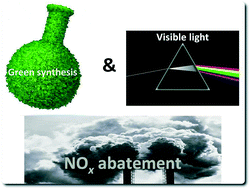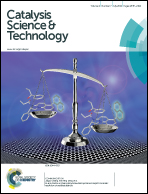Influence of sol counter-ions on the visible light induced photocatalytic behaviour of TiO2 nanoparticles†
Abstract
Titanium dioxide (TiO2) nanoparticles are attracting increasing interest because of their superior photocatalytic and antibacterial properties. Here, aqueous titanium oxy-hydroxide sols were made, using a green synthesis method, from the controlled hydrolysis/peptisation of titanium isopropoxide. Three different mineral acids were used to peptise the sol (HNO3, HBr and HCl), and provide counter-ions. The influence of nitrate or halide sol counter-ions on size distributions of the starting sols were measured via photon correlation spectroscopy (PCS). Semi-quantitative phase composition analysis (QPA), on the gels thermally treated at 450 and 600 °C, was carried out via Rietveld refinement of the X-ray powder diffraction (XRD) patterns. Photocatalytic activity of the prepared samples was also assessed, in the gas–solid phase, monitoring NOx degradation using both solar and white lamps (artificial indoor lightning). Both halides (chlorine or bromine) encouraged the anatase-to-rutile phase transition (ART), resulting in powders containing up to 77 wt% rutile and only 5 wt% brookite after heating to only 450 °C, with particle sizes ~50 nm, and these produced 100% rutile at 600 °C. Photocatalytic tests in the gas phase, using a white lamp, showed that the halide-stabilised sols, thermally treated at 450 °C, gave titania with the highest NOx conversion rate – twice that of Degussa P25.


 Please wait while we load your content...
Please wait while we load your content...